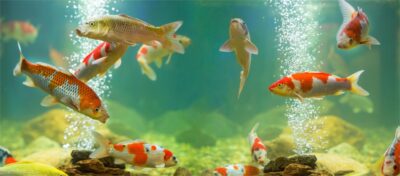Pond dye improves water quality, enhances pond beauty, and provides a natural shade for your pond. In this article, you will learn all about pond dyes and how to select the proper one for your pond or lake.
The benefits of Pond Dye
Aside from changing the appearance of your water, pond dye has several other benefits. In addition to providing aesthetic benefits, it also limits sun exposure, promotes fish health, and creates a healthy ecosystem in your pond.
Algae and plants submerged in water flourish when sunlight is too strong. Keeping your pond clean and maintaining clarity is easier when you use dye that blocks specific wavelengths of sunlight. Floating plants (e.g. water lilies) and emergent plants (e.g. cattails) are not inhibited by pond dyes. Here are more details about aquatic plants and weeds and how to manage them.
Additionally, you can keep your fish safe by using pond dye in two ways. The fish will have more time to flee to safety since predators will be less likely to see them when flying above or lurking beside the pond. The second consequence of the rising temperatures in the pond is the reduction of dissolved oxygen. Fish will have an easier time breathing during the summer if pond dye is used.
Dye colors for ponds
The addition of dye to your pond will enhance your landscape’s natural beauty and increase its natural color. The colors include bright blue, dark blue, blue-green, blue-black, and black. The choice of color is a personal choice since assorted dyes provide the same protection and shading for the pond. As a result, different shades suit different types of ponds, so you should take this into consideration when choosing a color, as well as what looks natural.
- Are you considering buying bright blue dye for your lake or pond? Choose Nature’s Blue dye, the most popular choice among customers. This color compliments lush green landscaping perfectly, making it a perfect choice for large ponds with views.
- Considering a darker shade of blue? Then try the Dark Blue Pond Dye. Adding a deep shade like True Blue to your pond will make it pop and really stand out.
- Have you ever wanted your home to remind you of a peaceful vacation? Blue-Green Pond Dye can provide just that. In order to absorb specific wavelengths of light, Caribbean Blue, a special blend of blue and yellow dyes, is recommended. A turquoise color is the result, which looks good on sand beaches.
- Are you looking for a way to show off your landscape? Check out Black Pond Dye! If you want to dye your pond, consider Black DyeMond. Designed to add beauty to brown or gray waters, this option can transform them. Reflecting the trees and landscapes around it, the mirrored surface is perfect for natural ponds in wooded areas.
- Does a natural look appeal to you more than blue-black pond dye? Twilight Blue dye is a good option. While maintaining a neutral blackish-blue hue, it shades your pond and protects it without producing drastic changes in its natural appearance.
It is also encouraged to mix and match dyes to find the color that looks the best on you if you are looking for a different shade similar to those listed above. Keep the dosage instructions in mind.
How to Apply
Ponds and lakes can be dyed easily by adding dye. To use, simply squirt the concentrated dye or throw the water-soluble packets in the pond. After just a few minutes, it will look like a natural pond. Once you pour the dye in, you can always add more, but it won’t dilute unless evaporation, rain, and time pass. The lifespan of pond dyes will vary based on rainfall, but it will typically last from four to eight weeks.
In the absence of knowledge of the average depth of your pond, determining how much pond dye to use may be difficult. The average dye can treat an acre of soil to a depth of 4-6 feet. Using a weighted string and your boat, you can determine how deep your pond is. When you have a good estimate of the average depth, check different areas.
Apply the liquid dye in smaller amounts if you cannot measure the depth. It shouldn’t take long for the color to spread throughout the water column after application. Make sure you record your dye use so you can prepare for the next treatment. Add until the desired color is achieved.
Also, it may be helpful if your pond has a lot of floating debris. Because it contains a dye and beneficial bacteria from PondClear, it shades the water while also helping to clear it. After an algaecide or herbicide treatment, this option is a great choice.
Pond Dye: Is it safe?
It is a common concern when using any dye to determine whether or not it will stain clothes, skin, or other surfaces. While adding pond dye to a pond or lake, be sure to wear gloves and work clothes since pond dye is powerful and can cause stains. It is possible, however, that the dye will be diluted throughout the pond after 24 hours and will no longer stain the water.
Aquatic dyes are completely safe for use in agriculture and irrigation once dissolved in water. Your pond will be available for recreational activities, fishing, and more after the treatment.










